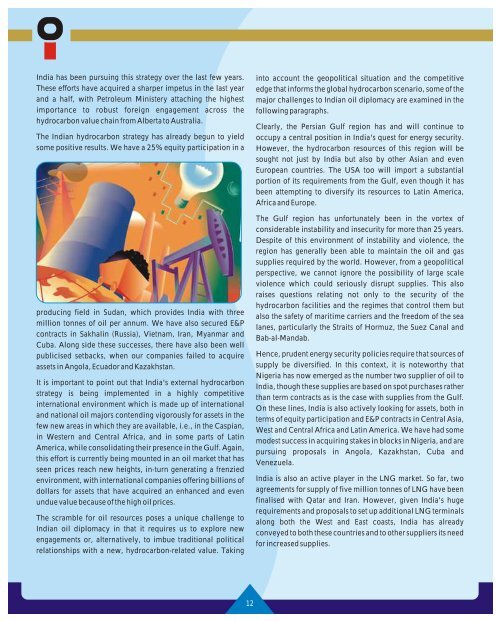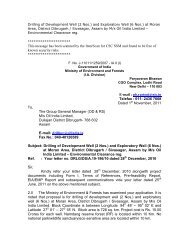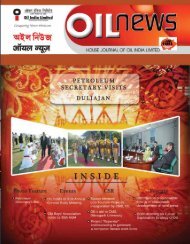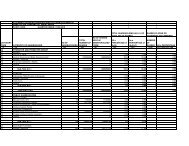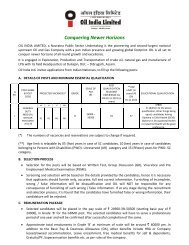2006 - Oil India Limited
2006 - Oil India Limited
2006 - Oil India Limited
You also want an ePaper? Increase the reach of your titles
YUMPU automatically turns print PDFs into web optimized ePapers that Google loves.
<strong>India</strong> has been pursuing this strategy over the last few years.<br />
These efforts have acquired a sharper impetus in the last year<br />
and a half, with Petroleum Ministery attaching the highest<br />
importance to robust foreign engagement across the<br />
hydrocarbon value chain from Alberta to Australia.<br />
The <strong>India</strong>n hydrocarbon strategy has already begun to yield<br />
some positive results. We have a 25% equity participation in a<br />
producing field in Sudan, which provides <strong>India</strong> with three<br />
million tonnes of oil per annum. We have also secured E&P<br />
contracts in Sakhalin (Russia), Vietnam, Iran, Myanmar and<br />
Cuba. Along side these successes, there have also been well<br />
publicised setbacks, when our companies failed to acquire<br />
assets in Angola, Ecuador and Kazakhstan.<br />
It is important to point out that <strong>India</strong>'s external hydrocarbon<br />
strategy is being implemented in a highly competitive<br />
international environment which is made up of international<br />
and national oil majors contending vigorously for assets in the<br />
few new areas in which they are available, i.e., in the Caspian,<br />
in Western and Central Africa, and in some parts of Latin<br />
America, while consolidating their presence in the Gulf. Again,<br />
this effort is currently being mounted in an oil market that has<br />
seen prices reach new heights, in-turn generating a frenzied<br />
environment, with international companies offering billions of<br />
dollars for assets that have acquired an enhanced and even<br />
undue value because of the high oil prices.<br />
The scramble for oil resources poses a unique challenge to<br />
<strong>India</strong>n oil diplomacy in that it requires us to explore new<br />
engagements or, alternatively, to imbue traditional political<br />
relationships with a new, hydrocarbon-related value. Taking<br />
into account the geopolitical situation and the competitive<br />
edge that informs the global hydrocarbon scenario, some of the<br />
major challenges to <strong>India</strong>n oil diplomacy are examined in the<br />
following paragraphs.<br />
Clearly, the Persian Gulf region has and will continue to<br />
occupy a central position in <strong>India</strong>'s quest for energy security.<br />
However, the hydrocarbon resources of this region will be<br />
sought not just by <strong>India</strong> but also by other Asian and even<br />
European countries. The USA too will import a substantial<br />
portion of its requirements from the Gulf, even though it has<br />
been attempting to diversify its resources to Latin America,<br />
Africa and Europe.<br />
The Gulf region has unfortunately been in the vortex of<br />
considerable instability and insecurity for more than 25 years.<br />
Despite of this environment of instability and violence, the<br />
region has generally been able to maintain the oil and gas<br />
supplies required by the world. However, from a geopolitical<br />
perspective, we cannot ignore the possibility of large scale<br />
violence which could seriously disrupt supplies. This also<br />
raises questions relating not only to the security of the<br />
hydrocarbon facilities and the regimes that control them but<br />
also the safety of maritime carriers and the freedom of the sea<br />
lanes, particularly the Straits of Hormuz, the Suez Canal and<br />
Bab-al-Mandab.<br />
Hence, prudent energy security policies require that sources of<br />
supply be diversified. In this context, it is noteworthy that<br />
Nigeria has now emerged as the number two supplier of oil to<br />
<strong>India</strong>, though these supplies are based on spot purchases rather<br />
than term contracts as is the case with supplies from the Gulf.<br />
On these lines, <strong>India</strong> is also actively looking for assets, both in<br />
terms of equity participation and E&P contracts in Central Asia,<br />
West and Central Africa and Latin America. We have had some<br />
modest success in acquiring stakes in blocks in Nigeria, and are<br />
pursuing proposals in Angola, Kazakhstan, Cuba and<br />
Venezuela.<br />
<strong>India</strong> is also an active player in the LNG market. So far, two<br />
agreements for supply of five million tonnes of LNG have been<br />
finalised with Qatar and Iran. However, given <strong>India</strong>'s huge<br />
requirements and proposals to set up additional LNG terminals<br />
along both the West and East coasts, <strong>India</strong> has already<br />
conveyed to both these countries and to other suppliers its need<br />
for increased supplies.<br />
12


